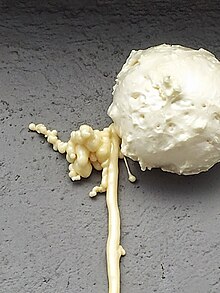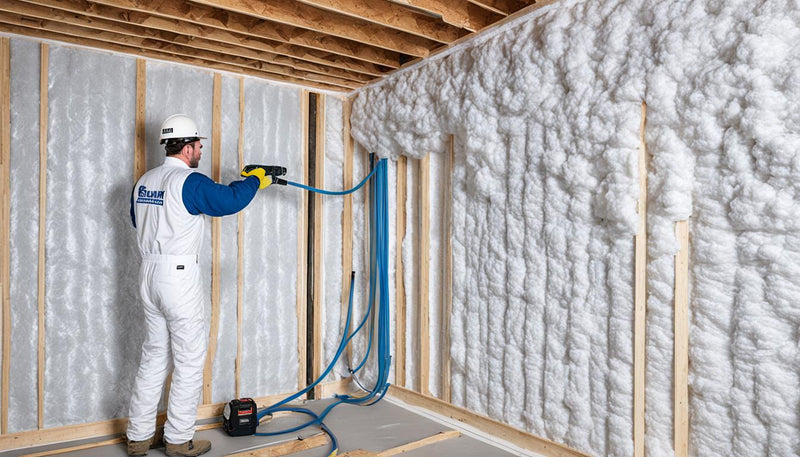The Process of Using Spray Foam: What You Need to Know
The Process of Using Spray Foam: What You Need to Know
Blog Article
Spray Foam: The Ultimate Option for Air Sealing and Insulation
Spray foam insulation has actually emerged as a leading service for effective air securing and thermal insulation, using a distinct combination of properties that establish it apart from typical techniques. Comprehending the full range of its advantages, installment processes, and comparisons with various other insulation types is important for making informed decisions.
What Is Spray Foam?
Spray foam is a functional insulation material that combines the concepts of air sealing and thermal resistance to enhance power efficiency in structures. Composed largely of polyurethane or various other similar substances, spray foam is applied as a fluid that broadens upon contact with surface areas, developing a strong, continual layer of insulation. This special residential or commercial property permits it to load spaces, cracks, and gaps that conventional insulation products may forget, supplying an exceptional air seal.
There are 2 primary types of spray foam: open-cell and closed-cell. Open-cell spray foam is lighter and extra flexible, supplying exceptional audio absorption and a lower R-value per inch - Spray Foam. On the other hand, closed-cell spray foam is denser, supplying a higher R-value, wetness resistance, and included structural stability to developing elements
The application procedure normally involves specific tools, guaranteeing a smooth application that adheres to numerous substrates, including concrete, steel, and timber. This adaptability makes spray foam suitable for both new building and constructions and retrofitting existing structures. Its capability to develop an airtight barrier substantially adds to lowering energy usage and enhancing interior air top quality, thereby making it a preferred option amongst contractors and house owners alike.
Benefits of Spray Foam Insulation
One of the most significant advantages of spray foam insulation is its outstanding capacity to develop a continual air obstacle, which properly decreases power loss. Unlike traditional insulation materials, spray foam expands to fill cracks and spaces, making certain that air leakage is significantly lowered. This particular not just improves power effectiveness however likewise causes reduce utility bills gradually.
In addition, spray foam insulation supplies remarkable thermal resistance, contributing to a more stable interior atmosphere. Its high R-value per inch permits for effective insulation in confined rooms, making it perfect for attics, wall surfaces, and crawl rooms. The moisture-resistant residential properties of spray foam help stop mold and mildew and mold growth, promoting much healthier living conditions.
An additional important benefit of spray foam insulation is its sound-dampening qualities (Spray Foam). It effectively minimizes noise transmission in between rooms, developing a quieter and more comfy home environment. The durability of spray foam additionally stands apart, as it does not droop or resolve over time, preserving its performance throughout its lifespan
How Spray Foam Works
Comprehending just how spray foam insulation functions is vital for appreciating its performance in air sealing and thermal resistance. Spray foam insulation contains 2 primary elements: isocyanate and polyol material. When these components are blended, they undertake a chemical reaction that creates the product to expand quickly, developing a dense foam that fills cavities, fractures, and voids.
As the foam expands, it follows surfaces, developing a closed seal that significantly decreases air infiltration. This particular makes spray foam insulation very effective at stopping drafts and moisture infiltration, which can cause energy loss and damage over time. Furthermore, the closed-cell version of spray foam provides superior thermal resistance due to its rigid framework, successfully minimizing heat transfer.
The distinct residential or commercial properties of spray foam permit it to adapt irregular surfaces, making sure detailed protection and a seamless obstacle. Consequently, spray foam insulation not just improves power efficiency but additionally adds to boosted interior air high quality by minimizing the accumulation of toxins and irritants. this content Eventually, comprehending the mechanics behind spray foam emphasizes its function as a superior selection for insulation and air securing in both property and commercial applications.
Setup Refine Overview

Before installment, the area needs to be effectively cleaned up and prepped, making certain that surfaces are totally free from dust, moisture, and debris. Due to the fact that important source impurities can endanger bond and general efficiency, this action is essential. As soon as the location is prepared, the application entails mixing the 2 parts of the spray foam, which expands upon get in touch with and fills up voids successfully.
Trained specialists ought to perform the installation, utilizing specialized equipment to make sure consistent coverage and optimum density. Security preventative measures, consisting of using protective gear and ensuring proper air flow, are necessary throughout this process. After application, the foam usually remedies quickly, developing a strong barrier that enhances power performance.
Contrasting Spray Foam to Standard Insulation
When examining insulation options, spray foam insulation stands apart in comparison to typical products such as fiberglass and cellulose. One of the key benefits of spray foam is its remarkable air sealing abilities. Unlike fiberglass and cellulose, which can enable air infiltration, spray foam expands upon application, loading gaps and gaps to develop an impermeable seal. This causes enhanced energy performance, as much less warmed or cooled down air runs away the home, leading to reduced utility expenses.
Furthermore, spray foam supplies a greater R-value per inch than typical insulation kinds, offering even more efficient thermal resistance in a thinner account. This characteristic is specifically helpful in rooms with restricted dental caries deepness. In addition, spray foam is resistant to moisture and mold and mildew development, which can be a considerable concern with cellulose and fiberglass, especially in moist atmospheres.
Nevertheless, spray foam insulation typically brings a greater upfront cost than its standard equivalents. Homeowners should consider this initial investment against long-lasting power financial savings and performance benefits. Eventually, while both insulation kinds offer their objective, spray foam becomes an advanced option for contemporary insulation demands, particularly in terms of air securing and thermal effectiveness.

Conclusion
In summary, spray foam insulation represents an extremely efficient service for accomplishing ideal air securing and thermal resistance. Its special properties, including moisture resistance and helpful hints audio dampening, make it ideal for numerous applications in both brand-new constructions and retrofitting jobs (Spray Foam). The first prices may be higher contrasted to traditional insulation products, the long-lasting benefits, such as significant energy savings and enhanced interior air top quality, warrant the investment and highlight its worth in modern-day building methods.
Spray foam insulation has actually arised as a leading service for efficient air securing and thermal insulation, providing a distinct mix of properties that establish it apart from standard techniques.Spray foam is a flexible insulation product that combines the concepts of air securing and thermal resistance to boost power performance in buildings.When evaluating insulation options, spray foam insulation stands out in contrast to standard products such as fiberglass and cellulose. Ultimately, while both insulation types offer their objective, spray foam arises as a more sophisticated solution for modern-day insulation needs, particularly in terms of air securing and thermal efficiency.
In summary, spray foam insulation represents a highly efficient solution for attaining ideal air sealing and thermal resistance.
Report this page